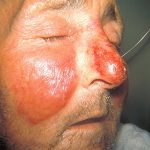 Is an intensely red Streptococcus bacterial infection that occurs on the face and lower extremities.
Is an intensely red Streptococcus bacterial infection that occurs on the face and lower extremities.
Is an acute streptococcus bacterial infection marked by deep red inflammation of the skin and mucous membranes. This disease is also known as Saint Anthony’s fire.
An acute inflammation disease of the skin caused by infection by various strains of Streptococcus and accompanied by fever.
An acute infectious disease of the skin caused by streptococci.
A contagious skin disease, where the skin on the face becomes hot, red and painful, caused by Streptococcus pyogenes.
Contagious, infective disease of skin and subcutaneous tissue, with redness and swelling of affected areas, and constitutional symptoms frequently of a severe nature.
Acute skin disease, caused by infection with bacteria of the genus streptococcus (especially Streptococcus pyogenes) and characterized by redness, swelling, fever, pain, and skin lesions. Treatment is by antibiotics.
An acute, red, raised, sharply demarcated rash caused by streptococcal bacteria. The rash can appear on the face and lower legs and occasionally on the arms. Streptococcus is the same bacteria that causes strep throat and some wound infections. Infection may occur in breaks in the skin caused by trauma, ulcers, or bites and occurs most often in older people and people with diabetes.
An infection of the skin and underlying tissues with the bacterium Streptococcus pyogenes. The affected areas, usually the face and scalp, become inflamed and swollen, with the development of raised patches that may be several inches across. The patient is ill, with a high temperature. Attacks may recur in certain individuals, possibly because of a defect in their lymphatic systems. Treatment is with antibiotics.
A streptococcal infection of the skin characterized by an acute onset with fever, malaise and a striking, usually unilateral, rash almost always on a lower leg or the face. Shivering, local pain and tenderness are associated with a sharply defined, spreading, bright red swollen zone of skin inflammation. On the leg, blistering and purpura may follow. The bacteria enter the skin through a fissure in a toe cleft (often associated with tinea pedis) or via a crack in the skin behind an ear or in a nostril.
An infection of the skin (usually caused by group A streptococci) that is marked by a bright red, swollen, sharply defined rash (that stings or itches) on the face, scalp, arms, legs, or trunk. Systemic symptoms such as fevers, chills, sweats, or vomiting may occur; local tissue swelling and tenderness and blistering of the rash are common. A toxin released into the skin by Streptococcus pyogenes creates many of the signs and symptoms of the infection. Erysipelas occurs primarily in children, adults over age 60, people with immunocompromising illnesses, and individuals with prior lymphatic or venous obstruction or surgery.
Erysipelas is a condition caused by a streptococcal infection that results in inflammation and blistering, primarily on the face. Accompanied by high fever and a general feeling of discomfort, this disease predominantly impacts young children and the elderly. Penicillin medications are typically used for treatment.
A severe, infectious skin inflammation caused by a streptococcal bacteria, marked by symptoms such as fever, headache, and expanding red, oval-shaped patches on the skin. Treatment with antibiotics usually controls and eradicates the condition within two to three days. Before the advent of penicillin, erysipelas posed a significant health risk, particularly for individuals over the age of sixty, and was often considered a fatal diagnosis. It is sometimes incorrectly referred to as St. Anthony’s fire.
An acute, surface-level type of cellulitis that affects the dermal lymphatics, typically caused by group A streptococcal infection. It is primarily characterized by a rapidly spreading, hot, bright red, swollen, firm, and sharply defined plaque with a raised, hardened border.
